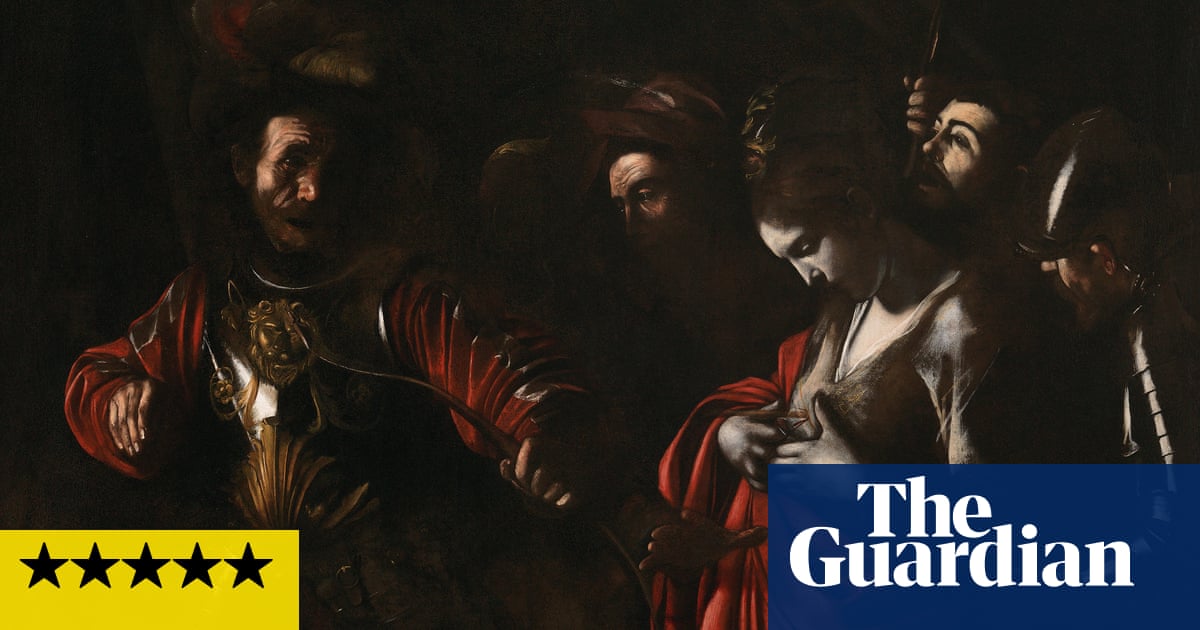
At the height of his fame in Rome, Michelangelo Merisi da Caravaggio is known to have owned at least 12 books. We don’t picture Caravaggio as a reader. A streetfighter, a killer, yes – but not an intellectual. Yet his painting The Martyrdom of Saint Ursula, which has come to the National Gallery from Naples, proves he could mine a book for its hidden diamonds.
The tale of Ursula, an early Christian princess from Britain who sailed off to marry and hopefully convert a pagan prince accompanied by no less than 11,000 virgins, is one of the religious fairy tales recounted in an incredibly strange medieval compendium called The Golden Legend. Caravaggio obviously studied this 13th-century source carefully because he sees something in it no one else had.
Previous artists depicted its pageantry and epic travels, culminating in gory mass martyrdom. Caravaggio instead homes in on an intense isolated moment. Ursula’s 11,000 companions were slain by “the Hunnish tribe” at Cologne (to quote William Granger Ryan’s translation), but Ursula was spared. The chief of the Huns “was dazzled by her wondrous beauty”. He tried to cheer her up – hey, sorry about the mass martyrdom – and asked her to marry him. “But she scorned his offer, and he, seeing that she despised him, transfixed her with an arrow.”
This is what Caravaggio paints. The Hunnish king is possessed by rage, his face fiery red, as furious as the lion on his bronze breastplate. He’s just shot the arrow at point blank rage. Ursula looks down, her face calm, at the shaft buried in her chest. There are no armies, no mounds of corpses as in earlier depictions. Instead, Caravaggio does what his contemporary Shakespeare did with Holinshed and Cinthio to create Macbeth and Othello: he extracts the human juice from the clattering narrative.
This is a great drama played out in the depths of night – and the National Gallery stages it that way. The Martyrdom of Saint Ursula hangs in a stark space with a handful of supporting documents and one other painting. It’s hypnotic. London theatre may be pricey but here’s a dumbfounding drama of rage, violence, death and maybe guilt, regret and acceptance – and you can see it for free. It also has a cameo from Caravaggio himself, in the last self-portrait he ever painted, standing behind Ursula.
His eyebrows and hair are jet black. So are his eyes. It’s tempting to call them lightless, but there are two tiny specks of white in each. They reflect the light source laying bare these desperate figures in the night. That “cinematic” lighting has made Caravaggio a superstar in the screen age. But he startled early 1600s Rome, too, by observing actual light. Set in humble rooms or side streets, the scenes in paintings like The Calling of Saint Matthew are illuminated by a single source from the side that exposes bold details out of surrounding darkness.
after newsletter promotion
The Martyrdom of Saint Ursula has that same focused light, but the beam is extremely narrow, as if filtered through a slit. It picks out bits of the scarred, weathered face of the Hunnish chief leaving his other features in the unlit void. Beside him, a witness has a face that’s just a nose and eye. Caravaggio’s own face is similarly mutilated. The top half is lit while his mouth, open in a howl of horror, is barely discernible.
Is this reflecting the trauma of Caravaggio’s recent escapades? The National Gallery believes this is his very last painting. Not long before he made it, he was attacked outside an inn in Naples, his face brutally cut up, leaving him “unrecognisable” according to a 17th-century writer. So maybe the partially seen, partially hidden faces reflect his sense of disfigurement. An armoured soldier to the far right has the most unrecognisable face of all, just a nose under his helmet.
The only person who’s fully lit is Ursula. Yet the light on her is pale and eerie. Although it comes from a single source, the light seems to have changed by the time it reaches her. The Hun leader is in a red glow as if lit by a campfire. But Ursula is in white moonlight, as she enters death – and heaven. For all this, the Hun chief is the painting’s emotional centre. His face, at first just savage, is full of contorted emotions. As Ursula stands there, still alive with his arrow in her, he sees the dreadful irreversibility of what he has done.
It’s a realisation Caravaggio knew all too well. Documents testify to the painter’s violent temper, from beating up a waiter over some artichokes to killing a man. What must have struck him in the story of Ursula’s death is the lethal volatility of the chief’s rage: the moment Ursula rejects him, he shoots her.
Caravaggio always gives people filthy fingernails, but look at this murderer’s nails and you’ll see what look like infected talons, one whole hand turning into a demonic claw. Ursula is still. She has got her martyrdom: a holy blessed fate in the eyes of the church. But what has her killer got? Damnation. Caravaggio is surely looking at him and thinking: Is that me?
I’ve seen blockbusters that bored me stiff. This exhibition, dedicated to just one masterpiece, held me transfixed, just like Ursula.